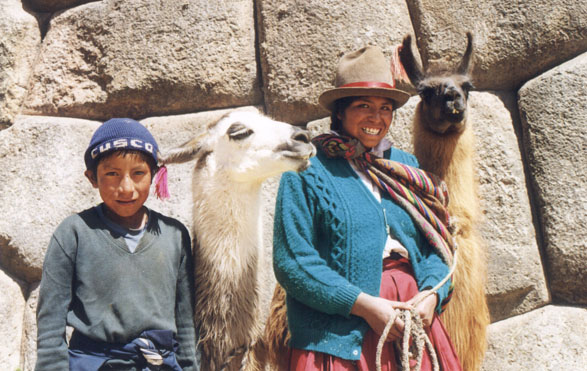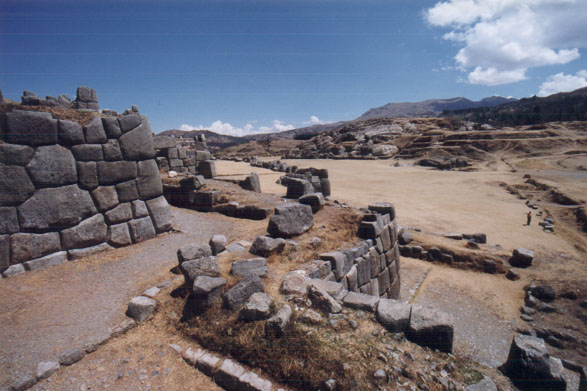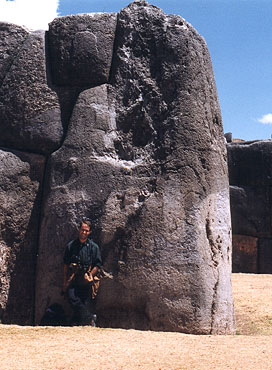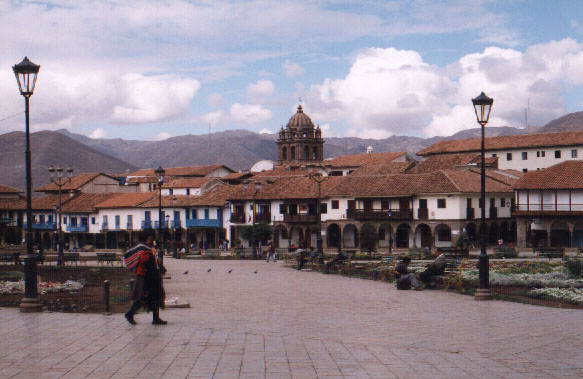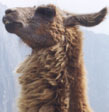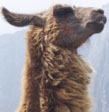By the time we climbed down from Sacsayhuaman it was mid-afternoon. Susanne and I wanted to stop by the tour agency that had planned our Sacred Valley trip to see what arrangements had been made for our excursion to Machu Picchu. Luis Guillen, the man who had helped us previously, wasn't around yet so they suggested we come back in 20 minutes or so. Susanne and I decided to walk to the Iglesia Santo Domingo, a Dominican church built over the Incan temple of Coricancha. In its time Coricancha was one of the greatest temples of the Tawantinsuyu empire. Coricancha, Quechua for Golden Courtyard, proved a fitting name for this place since its outer walls were covered with a staggering 700 sheets of gold, each weighing in excess of four pounds. Sadly, the Spanish melted down every ounce of gold in a matter of weeks after capturing the city. None of the riches of Coricancha survived the conquest. Francisco Pizarro's brother Juan was given the temple as his private estate but he soon died in the battle of Sacsayhuaman in 1536. Juan's will stipulated that the temple be given to the Dominicans, and they've occupied it ever since in the form of Iglesia Santa Domingo. The outside of Coricancha/Domingo is a testimony to the history of Cusco. The lowest level of the structure represents architecture of the early Inca period. The middle layer is a grand example of classic Inca architecture at the peak of empire. The top layer is, of course, Spanish colonial. Just as layers of earth can represent epochs of time, the layers of Coricancha tell a story of imperial birth, growth and collapse.
Coricancha lies at the end of Calle Loreto, not far from our hotel. The last time we walked down this long street of Inca stone, the skies opened and poured rain on us. Today seemed to be no exception: as we penetrated further down towards the church the skies clouded over. By the time we reached the ancient temple a foreboding blue-black cloud blotted out the sun. Today, apparently, would not be a day to fully appreciate Coricancha. We contemplated its exterior layers of Inca and Spanish architecture for several minutes before retreated back down Loreto. Like clockwork, the closer we returned to our familiar surroundings at the Plaza de Armas, the sooner the clouds cleared, reinstating the sun to dominate the skies above.
Having returned to the plaza we figured it was as good a time as any to visit Cusco's cathedral. It's hard to give an impression of the cathedral's interior except to stress its darkness. As far as cathedrals go, this one was unusual for its utter lack of windows, be they stained glass or otherwise. The darkness made it very difficult to appreciate what was probably a beautiful church. The Quechua artisans of Cusco had little to go on when the Spanish set them out to paint Catholic churches. Apart from a resident Van Dyke and some Spanish renaissance paintings, the local artesenias had never seen European religious art before. This ignorance led to the evolution of a unique style of painting known as the Cusqueño school. Cusco cathedral is perhaps the world's best collection of Cusqueño religious art, but the interior of the church was so dark I found it difficult to appreciate it. Perhaps one day I'll return on a major holiday when the entire cathedral is awash with the flicker of candles. That might make all the difference.
After sending emails to our families from a local Internet café we returned to the tour agency to find Luis. Alas, he still wasn't there; his assistant said he was stuck at the airport. Another agent, Carlos Quispe, promised us that Luis would pick us up at 5:45am the next morning to catch the 6:30am tourist train to Machu Picchu. Luis would have our tickets and vouchers to visit the ruins and to stay at a hotel in Aguas Calientes, a small jungle village 1500 feet below the ruins. I didn't like the idea of not having our tickets until the morning of our departure but I realized that's the way the game was played here in Cusco. Tour operators controlled the whole Machu Picchu tourist trade; it's extremely inconvenient to put together your own plans without their help. A case in point: in early August Susanne had telephoned a popular hotel in Aguas Calientes affectionately known as Gringo Bill's in order to make a reservation for our stay. Today we called them to reconfirm but they changed their tune and now insisted we go to a specific tour operator in Cusco and purchase hotel vouchers from them. Of course, this operator wasn't the same agency we had been dealing with, and our guys could only get us the vouchers at an inflated rate. To make matters worse, each time we ran by the other tour agency it was closed, a large padlock latched defiantly to the door. Eventually we concluded that Gringo Bill's must now be managed by jerks, so we grudgingly accepted a hotel voucher from our agents. The hotel, La Cabaña, received grim reviews from Lonely Planet - "stark" and "basic," or something to that effect. Carlos promised us that the hotel was now much nicer and swore we would have a private bath with hot water. We'd just have to see about that.
After finally settling our hotel situation I was in bad need of a beer. We visited the Cross Keys Pub, a quasi-British hangout on the southern end of the plaza. Susanne started with a Coke while I tried the local cerveza, Cusqueño. I sat on the balcony writing in my journal until it became too chilly to sit outside. Susanne had resettled inside the pub next to a roaring fireplace. We were in no rush to leave so I ordered a coffee while Susanne snacked on a small plate of cookies. The remainder of the afternoon passed by as I continued to work my journal, hoping to get caught up with the day's events.
Around 6pm we decided to get an early dinner at the Inka Grill. The restaurant appeared to be a recently refurbished place that played up a nouveau cuisine atmosphere, even though the menu didn't stray far from standard Cusco fare. Susanne and I both each ordered a bowl of quinoa soup and split an entree of lomo saltado (sort of a beef teriyaki with fries). We sipped our maté de coca as the bartender channel-surfed on the resident TV: Beastie Boys on MTV ("Intergalactic"), local soap operas, the evening news. He eventually settled on the Discovery Channel, which turned out to be showing a accurate summary the last two years of our travels. As a program featuring Bangkok's Wat Po wrapped up, we were then treated to the highlights of northern India, including Humayun's Tomb in Delhi and the majestic palace of Fatehpur Sikri. I've rarely seen any of these monuments on TV back in the States so it was a little odd to catch them while here in South America. The quinoa soup was really a fish soup - trout, I think - with only hints of quinoa sunk to the bottom of the bowl. Nonetheless it was quite delicious. Our lomo saltado soon arrived and we ravenously devoured it. Not long after finishing dinner I felt a disconcerting rumble in my intestines as I paid the bill. I took this disturbance as foreshadowing possible trouble over the coming days.
Along the perimeter of the plaza we stumbled upon the evening market, a nightly cavalcade of Quechua art, trinkets, candies, woolen goods, and practically anything else a Gringo might desire while passing through Cusco. I considered buying an alpaca sweater, for the sweatshirt I had packed for the trip had proven to be poor protection against the chilly Andean night. Most of the market stalls had similar sweaters, each with a checkered pattern around the neck hole. I didn't really care for the style so I ducked into a shop to check out its selection. I soon found a nice sweater Susanne and I both liked, though it appeared to be too small for my build. Susanne encouraged me to try it on anyway; to my surprise, the sweater fit perfectly. I asked the shop owner how much she wanted for it. "Cinquenta y neuve soles," she replied, just under 20 dollars. Inwardly I was ready to buy it, but ever the negotiator, I removed the sweater and said, "Cinquenta y neuve? Más barato, por favor. It's too expensive." Wanting to recover the sale the owner grabbed a similar garment and said, "Treinta soles - cinquenta perciento alpaca." Fifty percent alpaca wool for 30 soles, but what was the other half made out of? "Acrylic," she replied. "Forget it," I shook my head. "Ok, señor," she said. "How much, mister?" "35 soles," I answered. The woman began to spout something in Spanish I could only imagine meant "But sir, even the wool and workmanship alone are worth 40 soles. How can I stay in business for 35 soles?" I knew I was lowballing, but it got the reaction I wanted. "Okay," I said. "45 soles." "No, 50 soles," she replied. Sole by sole, I went up as she went down. Finally we both settled on 48 soles, about $16, for the 100% alpaca sweater. I was quite happy with the purchase.
My happiness soon faded as I attempted to go to sleep that night. My stomach growled with displeasure from eating the lomo saltado. What was I thinking? I don't even eat red meat in the States. Worse still, the coffee and Cusqueño I had guzzled at the Cross Keys Pub earlier that day had left me feeling simultaneously wired and dehydrated. My dehydration was probably exacerbated by the Diamox, which acts as a diuretic in its own right. I spent the entire night tossing and turning, my pulse racing as fast as my mind was from one useless thought to another.
The last time I checked the clock it was 3am; I have to get up at 4:45am to catch the train to Aguas Calientes and begin three potentially grueling days at Machu Picchu. I hope I can get at least an hour of sleep tonight.



